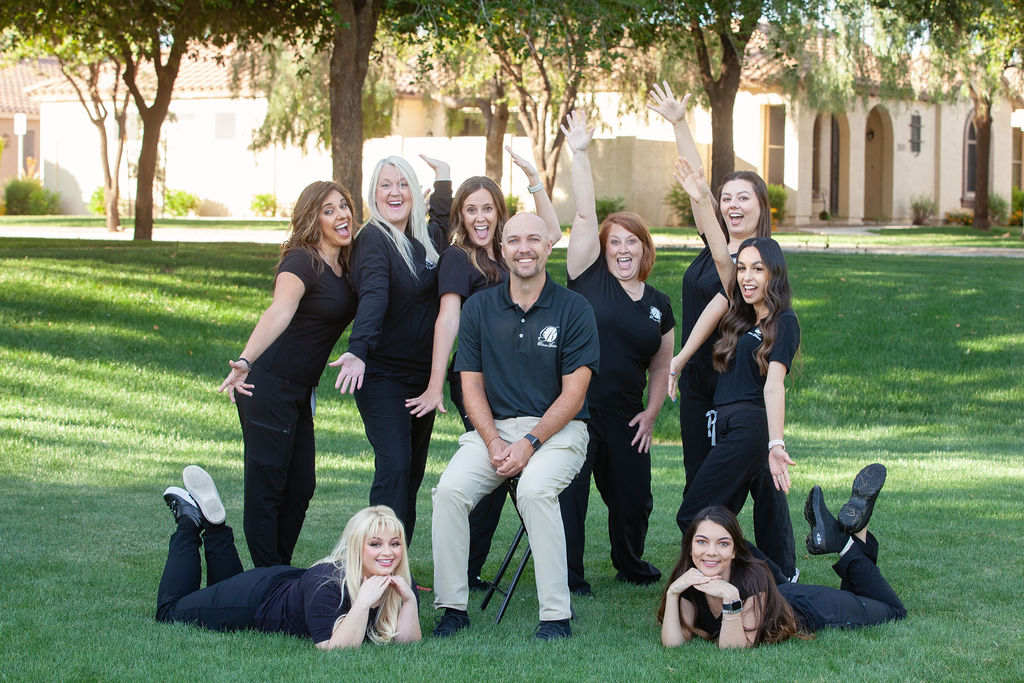Implant Retained Dentures
What Is It?
An implant-supported denture is a type of overdenture that is supported by and attached to implants. A regular denture rests on the gums, and is not supported by implants.
An implant-supported denture is used when a person doesn’t have any teeth in the jaw, but has enough bone in the jaw to support implants. An implant-supported denture has special attachments that snap onto attachments on the implants.
Implant-supported dentures usually are made for the lower jaw because regular dentures tend to be less stable there. Usually, a regular denture made to fit an upper jaw is quite stable on its own and doesn’t need the extra support offered by implants. However, you can receive an implant-supported denture in either the upper or lower jaw.

How Does It Work?
There are two types of implant-supported dentures: bar-retained and ball-retained. In both cases, the denture will be made of an acrylic base that will look like gums. Porcelain or acrylic teeth that look like natural teeth are attached to the base. Both types of dentures need at least two implants for support.
• Bar-retained dentures — A thin metal bar that follows the curve of your jaw is attached to two to five implants that have been placed in your jawbone. Clips or other types of attachments are fitted to the bar, the denture or both. The denture fits over the bar and is securely clipped into place by the attachments.
• Ball-retained dentures (stud-attachment dentures) — Each implant in the jawbone holds a metal attachment that fits into another attachment on the denture. In most cases, the attachments on the implants are ball-shaped (“male” attachments), and they fit into sockets (“female” attachments) on the denture. In some cases, the denture holds the male attachments and the implants hold the female ones.
The Implant Process
The implants usually are placed in the jawbone at the front of your mouth because there tends to be more bone in the front of the jaw than in the back. This usually is true even if teeth have been missing for some time. Once you lose teeth, you begin to lose bone in the area. Also, the front jaw doesn’t have many nerves or other structures that could interfere with the placement of implants.
The time frame to complete the implant depends on many factors. The shortest time frame is about five months in the lower jaw and seven months in the upper jaw. This includes surgeries and the placement of the denture. However, the process can last a year or more, especially if you need bone grafting or other preliminary procedures.
Two surgeries usually are needed. The first one places the implants in the jawbone under your gums. The second surgery exposes the tops of the implants. The second procedure comes three to six months after the first.
A one-stage procedure is now used sometimes. In this procedure, your dentist can place the implants and the supporting bar in one step. The success rate of this procedure is high.
Initial consultation
During the exam, Dr Roberts will review your medical and dental histories, take images and create impressions of your teeth and gums so that models can be made.
If you are not already wearing a complete denture to replace your missing teeth, your dentist will make you one.
First surgery
Month 1 (if no denture needs to be made)
Month 2 (if denture needs to be made)
The first surgery involves placing the implants in the jawbone. During the first surgery, an incision is made in the gum where the implant will be placed. A hole is drilled in the bone, the implant is placed into the hole, and the incision is stitched closed.
After this surgery, you should avoid putting pressure on the implants. A temporary denture can be made so that direct pressure is placed on other areas, not on the implants. It may also be given a soft reline (new lining next to your gums) to help to reduce the pressure on your gums.
After the first surgery, the dentist will wait three or four months if implants were placed in the lower jaw, and five or six months if they were placed in the upper jaw, before scheduling the second surgery. During this time, the bone and the implants integrate (attach and fuse).
Second surgery
Month 4 or 5 (no denture needed to be made)
Month 5 or 6 (denture needed to be made)
Once the implants have become fused with the bone, the second surgery can be scheduled. Your dentist will confirm whether the implant is ready for the second surgery by taking an X-ray. This surgery is simpler than the first. A small incision is made in your gum to expose the tops (heads) of the implants.
A healing cap (collar) is placed on the head of each implant after it is exposed. This guides the gum tissue to heal correctly. The collar is a round piece of metal that holds the gums away from the head of the implant. The collar will be in place for 10 to 14 days. The dentists will adjust your temporary denture again and it may be given another soft reline. The reline material will secure the denture to the healing abutments.
About two weeks after the second surgery, the healing caps will be replaced with regular abutments. Your gums should now be healed enough for your dentist to make an impression of your gum tissue and abutments. The impression is used to make a working model of your abutments and jaw. This model is used to make the denture framework and teeth.
Denture Try-In and Insertion
Month 5 or 6 (no denture needed to be made)
Month 6 or 7 (denture needed to be made)
At this point, the metal bar is placed on the abutments. You will have the first try-in of your new denture framework to see if it fits properly.
Once the metal bar and the denture framework have been fitted together properly, the teeth are temporarily placed on the framework in wax. The whole denture is then tried in your mouth. If everything works well, the teeth are secured in the denture framework permanently. The bar or ball attachments also will be secured.
You will have to return to Dr Roberts for another visit to have the completed denture inserted. When the denture is inserted, the denture is clipped onto the bar or snapped onto the ball attachments.
Possible Complications
In addition to the risks of surgery and of the implants failing, a bar-retained denture carries certain risks of its own.
A bar-retained denture needs space on the denture framework for the special attachments that are fitted to the bar. This means that there is less space available on the denture framework for the teeth to be fitted. Because of this, the teeth sometimes can come loose from the base. This problem is easily fixed.
What Can You Expect From Your Implant-Supported Denture?
Your implant-supported denture will be more stable than a regular denture. You will find it easier to speak and you won’t have to worry about the denture becoming loose or falling out of your mouth. You generally will be able to eat foods you could not eat before.
If you have an implant-supported denture in your upper jaw, it can be made to cover less of your palate (roof of your mouth) than a regular denture. That’s because the implants are holding it in place instead of the suction created between the full denture and your palate.
Great Dental Care Made Simple - Call or Visit Us Today

Office Hours
